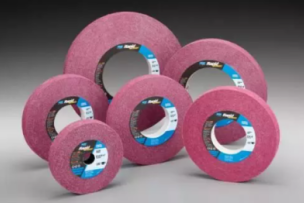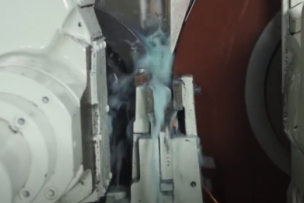Review and follow all of the machine and fiber disc manufacturer's recommendations. Do not run a coated abrasive disc on an unfamiliar machine without obtaining and following machine instructions.
Grinder Equipment
- Before mounting a disc for any type of machine repair, disconnect the grinder/sander from its power source to eliminate the possibility of the machine accidentally starting during mounting or repairing operations.
- Check the sander/grinder spindle for runout (wobble). If there is any runout, repair or replace the spindle.
- Select the proper grinder or sander for the job. Using a grinder for light sanding or blending may result in personal injury. Conversely, a tool that is too small or underpowered can result in safety problems because forcing the machine and abrasive disc can cause the disc to slip, snag, or break.
- Never exceed the speed rating (marked in RPM) of a back-up pad.
- Check the disc retainer nut for thread wear. Also check for a snug fit and full three-point contact except when using quick-change or non-wrench systems.
- Use the proper disc-mounting equipment. Never use adhesives to fasten discs to backup pads.
- If a grinder is used or if the sander is equipped with a guard, you must use it. Guards prevent injuries. Never remove a guard provided by the machine manufacturer.
- Many air-driven sanders, such as pistol grip air sanders, are ungoverned machines. Therefore, as with many pneumatic tools, you must use air regulators at each workstation. The speed of the sander is determined by the air pressure provided to the tool. If the machine is designed to operate at 20,000 RPM at 90 PSIG, do not exceed that air pressure; the speed of the machine can go up exponentially. Never mount a bonded grinding wheel on a pistol-grip air sander!
- If you selected an electrical power tool, make sure you use the correct voltage. Never attach a sander/grinder designed for 110 volts into a 220-voltage power source. Take all normal electrical tool precautions.
- Check electrical cords and air hoses for cracks and worn areas regularly.
Review any special grinding and handling instructions with the manufacturer of the work materials. If you are grinding combustible or other hazardous materials, look for instructions on special fire containment equipment, extinguishing materials, and other special requirements.
Personal Protective Equipment
Always use the proper PPE. PPE is an important safeguard for operators and bystanders of coated abrasive operations. Using the proper safety equipment can save eyes, limbs, and hearing and help prevent future respiratory problems.
4. USE GOOD FIBER DISC STORAGE PROTOCOLS
Humidity and temperature are the two very important factors influencing coated abrasive performance. Backings and adhesives are sensitive to the temperature and moisture of their surroundings. Improper or inadequate storage can damage discs, rendering them ineffective and making them unsafe.
Excessive humidity may cause the fiber backing of a disc to absorb moisture and curl up (convex shape like a taco shell) called cupping. Discs that are cupped or curled up should never be used. A disc in this condition may snag on the workpiece, causing it to break. Excessive moisture could also soften the adhesive bond, causing the disc to shed large amounts of abrasive grains.
Excessive dryness may cause the disc to curl or arch down (concave shape) and become brittle and lose flexibility.
Cold temperatures will cause a cold set condition. Consequently, these products should be stored at room temperature.
To keep your disc flat and safe, follow the manufacturer's storage instructions.
Store abrasive discs at 40% to 50% relative humidity and 60 to 80 degrees F (15 to 29 degrees C). Protect discs from exposure to water or other fluids and solvents. Coated abrasive discs should be stored at least 4 inches above the surface of concrete floors; away from open windows; out of direct sunlight; and away from heat sources such as radiators, steam pipes, and air conditioner exhaust vents.
Storing coated abrasive discs in their original packaging will help protect them. If packaging is received damaged, the product inside should not be used. Return any damaged product to its manufacturer. Never use hooks when handling or transporting coated abrasive containers.
Rotate stock, using it on a first-in, first-out basis.
Learn more about Norton's fiber disc offering, and check out their coated abrasive fiber disc safety guide for additional safety tips.
This article appears in the January 2021 issue of The FABRICATOR. Reproduced with permission.
Previously Featured on Norton's Resources page.







Talk to Us!
Leave a reply
Your email address will not be published. Required fields are marked *